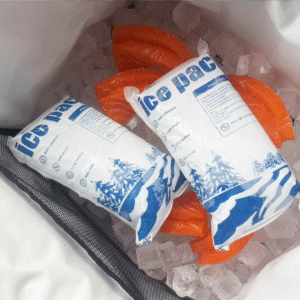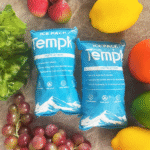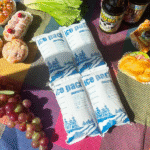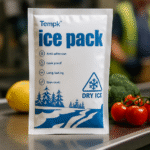Versand verderbliche Waren, vor allem in der Kaltkette -Logistikindustrie, erfordert eine sorgfältige Berücksichtigung der besten Kühlmethode. Trockeneis- und Gelpackungen sind die am häufigsten verwendeten Materialien, jedes hat unterschiedliche Vorteile. In diesem Artikel, Wir werden die Unterschiede zwischen diesen beiden Kühlmitteln untersuchen, leiten Sie bei der Auswahl an, und besprechen Sie deren Vorteile und Grenzen auf der Grundlage der 2025 Trends im Kühlkettenversand.

Was sind Trockeneis- und Gelpackungen??
Trockeneis (Solid Co₂):
Trockeneis ist gefrorenes Kohlendioxid, das bei -78,5 °C direkt vom Feststoff in den gasförmigen Zustand sublimiert (-109.3° F), Damit eignet es sich perfekt für extrem kalte Umgebungen. Im Gegensatz zu traditionellem Eis, Trockeneis hinterlässt keine Flüssigkeitsrückstände, Vermeidung möglicher Wasserschäden an empfindlichen Produkten.
Gelpackungen:
Gelpacks sind flexible Behälter, die mit einem ungiftigen Gel gefüllt sind, das gefriert und mit der Zeit allmählich Kälte abgibt. Sie funktionieren, indem sie Wärme aus der Umgebung absorbieren, Aufrechterhaltung der Temperaturen typischerweise im Bereich von 2–8 °C, Ideal für gekühlte Waren.
Wann sollten Sie Trockeneis für den Versand verwenden??
Trockeneis ist die erste Wahl beim Versand von Produkten, deren Temperaturen unter dem Gefrierpunkt bleiben müssen, wie Arzneimittel, Biologische Proben, oder gefrorene Lebensmittel. Aufgrund seiner Fähigkeit, extrem kalten Temperaturen über längere Zeiträume standzuhalten, eignet es sich ideal für Langstreckentransporte oder Sendungen in heißen Klimazonen.
Hauptvorteile von Trockeneis für den Versand:
-
Extreme Kälte: Hält Gegenstände deutlich unter -78,5 °C, unverzichtbar für Tiefkühlkost und medizinische Proben.
-
Lang anhaltende: Sublimiert langsam, bietet längere Kühlung.
-
Keine flüssigen Rückstände: Verhindert mögliche Produktschäden durch Schmelzen.
Praktisches Beispiel:
Ein Pharmaunternehmen, das Impfstoffe im ganzen Land verschickt, bevorzugt möglicherweise Trockeneis, um während der Reise die erforderlichen extrem niedrigen Temperaturen aufrechtzuerhalten.
Wann sollten Sie Gel-Packs für den Versand wählen??
Gelpackungen eignen sich am besten für Produkte, die kühl gehalten werden müssen, aber nicht gefroren. Sie sind ideal für temperaturempfindliche Waren wie Schokolade, Kosmetika, und bestimmte Medikamente. Gelpackungen bieten eine sicherere Lösung, ungiftige Alternative zu Trockeneis, und sie erfordern keine spezielle Handhabung oder Verpackung.
Hauptvorteile von Gel-Packs für den Versand:
-
Sicheres Handling: Keine Verbrennungs- oder Erstickungsgefahr, im Gegensatz zu Trockeneis.
-
Wiederverwendbarkeit: Gelpackungen können wiederverwendet werden, Dies macht sie zu einer kostengünstigeren und umweltfreundlicheren Option für häufige Sendungen.
-
Anpassbare Kühlung: Gelpackungen können so angepasst werden, dass sie bestimmte Temperaturbereiche einhalten, beispielsweise 2-8°C für pharmazeutische Produkte.
Trockeneis gegen Gelpackungen: Vor- und Nachteile-Vergleich
| Besonderheit | Trockeneis | Gelpackungen |
|---|---|---|
| Temperaturbereich | -78.5°C (-109.3° F) | 2-8°C (32-46° F) |
| Kühldauer | Lang anhaltende, kann tagelang anhalten | Typischerweise 12-48 Std. |
| Sicherheit im Umgang | Erfordert Vorsicht (Erfrierung, CO₂ -Aufbau) | Sicher, ungiftig |
| Verpackung | Erfordert eine belüftete Verpackung | Keine spezielle Verpackung erforderlich |
| Ideale Verwendung | Gefrorene Lebensmittel, Arzneimittel, Biologische Proben | Pralinen, Kosmetika, temperaturempfindliche Elektronik |
So wählen Sie zwischen Trockeneis- und Gelpackungen?
Die Entscheidung, welches Kühlmittel zum Einsatz kommt, hängt von mehreren Faktoren ab, einschließlich der Temperaturanforderungen des Produkts, die Versanddauer, und die Handhabungsrisiken.
-
Temperaturanforderungen: Wenn das Produkt eingefroren werden muss, Trockeneis ist die einzige Option. Für Produkte, die kühl, aber nicht gefroren bleiben müssen, Gelpackungen sind die beste Wahl.
-
Versanddauer: Für längere Sendungen eignet sich Trockeneis besser, während Gel-Packs ideal für kürzere Zeiträume sind, weniger kritische Sendungen.
-
Sicherheit im Umgang: Wenn Ihr Team nicht für den Umgang mit gefährlichen Materialien wie Trockeneis ausgestattet ist, Gelpackungen sind eine sicherere Alternative.
2025 Kaltkette Trends: Innovationen und Nachhaltigkeit
Während sich die Kaltkettenindustrie entwickelt, Nachhaltigkeit und Technologie werden immer integraler. In 2025, umweltfreundliche Alternativen zu herkömmlichen Kühlmethoden, wie biologisch abbaubare Gelpackungen und Trockeneis mit niedrigem GWP, erlangen an Popularität. Intelligente Verpackungen, Temperaturverfolgung, Auch Hybridlösungen aus Trockeneis und Gelpackungen erweisen sich als zuverlässige Methoden zur Gewährleistung der Integrität temperaturempfindlicher Güter.
Wichtige Trends für 2025:
-
Hybridlösungen: Kombinieren Sie Trockeneis mit Gelpackungen, um die Kühldauer zu verlängern.
-
Intelligente Verpackungen: Einbettung von Sensoren zur Temperaturverfolgung in Echtzeit.
-
Nachhaltigkeit: Erhöhte Nachfrage nach biologisch abbaubaren und wiederverwendbaren Kühllösungen.
FAQ:
Q1: Was ist besser für den Versand temperaturempfindlicher Produkte?, Trockeneis oder Gelpackungen?
Trockeneis eignet sich am besten für gefrorene Produkte, die extrem niedrige Temperaturen erfordern, während Gelpackungen ideal für Produkte sind, die kühl, aber nicht gefroren bleiben müssen.
Q2: Wie lange können Gelpacks die erforderliche Temperatur aufrechterhalten??
Gelpackungen halten normalerweise die Temperatur für 12 Zu 48 Std., abhängig von ihrer Größe und Kühlzusammensetzung.
Schlussfolgerung und Empfehlungen
Die Wahl zwischen Trockeneis und Gelpackungen für den Versand hängt von der Art Ihres Produkts ab, der erforderliche Temperaturbereich, und die Dauer Ihrer Sendung. Trockeneis ist für ultrakalte Waren unerlässlich, während Gelpackungen kostengünstiger und sicherer zum Kühlen sind, nicht gefrorene Artikel. Für viele Sendungen, Hybridlösungen, die beide Methoden kombinieren, können die besten Ergebnisse liefern.
Nächste Schritte:
-
Bewerten Sie Ihre Produkte: Stellen Sie fest, ob sie eingefroren oder nur kühl gehalten werden müssen.
-
Nutzen Sie Hybridlösungen: Erwägen Sie die Kombination von Gelpackungen mit einer kleinen Menge Trockeneis für längere Sendungen.
-
Führen Sie nachhaltige Praktiken ein: Entdecken Sie umweltfreundliche Gelpackungen oder Trockeneis mit niedrigem GWP, um die Umweltbelastung zu reduzieren.
Über Tempk
Tempk ist ein führender Anbieter nachhaltiger Kühlkettenlösungen, Wir bieten Trockeneis- und Gel-Packs für Branchen an, die eine zuverlässige Temperaturkontrolle benötigen. Unsere innovativen Lösungen sorgen dafür, dass Ihre Waren sicher und in optimalem Zustand ankommen. Kontaktieren Sie uns noch heute für eine maßgeschneiderte Beratung zu Ihren Anforderungen an den Kühlkettenversand.























